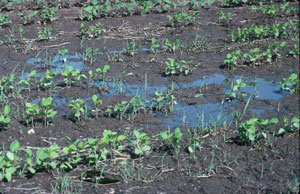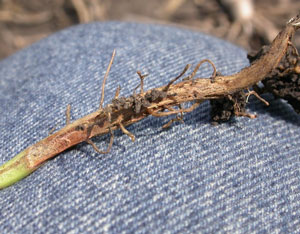Soybeans may face a number of obstacles to growth and development. Early planting of soybeans multiplies the number of potential obstacles. Here are some of the key threats that early-planted soybeans may face…
Pythium – Pythium is one of the “water molds,” an oomycete. It has a swimming infectious spore, so infection is usually associated with wet soils. Pythium is also favored under cool conditions, temperatures under 55°F. Initially, all plant parts may be infected and the disease can be expressed as a seed or seedling rot. As plants grow, the infection is usually confined to the lower stem and roots.
Seedling Blight Complex – The seedling blight complex is made up of several pathogens, including pod and stem blight, rhizoctonia, fusarium, pythium and phytophthora. Fusarium and rhizoctonia are dry rots. Pythium and phytophthora require free moisture in the soil in order for infection to take place. These pathogens also have differing temperature requirements. For example, pythium is active up to about 55°F, while phytophthora is just getting started at about 50°F. Meanwhile, rhizoctonia is very happy at soil temperatures around 80°F.
Sudden Death Syndrome – Sudden death syndrome is caused by the pathogen, Fusarium verguliforme. The pathogen is somewhat weak, so infection is favored when the soybeans are growing slowly, under cool soil conditions, when soybean cyst nematode is active, or when other stress factors are at work. Symptoms of sudden death syndrome usually appear late in the season, but infection occurs early.
Slugs – Slugs are related to snails and they feed with rasping mouthparts on both below, and above-ground, plant parts. Slug damage is favored with moist conditions and lots of residue for the slugs to hide under during the day. In soybeans, look for severed or gouged hypocotyls and cotyledons, or leaves that have been partially or completely stripped. Slugs survive the hot, dry part of the summer by seeking moist shelter and shaping themselves into kind of a ball shape to conserve moisture.
Seedcorn Maggots – Soybean seeds or cotyledons, or corn seeds may be attacked by seedcorn maggots when cool, moist conditions prevail, and germination and early growth are slowed. The flies, which are adults of the maggots, are attracted to decaying organic matter, manure, or other sources of organic matter. They lay eggs at or just below the soil surface and the newly hatched maggots immediately seek out organic matter or seeds. It is uncommon for the maggots to attack germinating seed in well drained or low organic matter soils where manure has not been applied.
Bean Leaf Beetles – Overwintering bean leaf beetles are attracted to emerging soybeans from long distances away. Early planted soybeans attract an undue amount of bean leaf beetle pressure. By the time other soybeans are emerging, the beetles disperse to these other fields, diluting the amount of damage. Soybean seedlings can tolerate a great deal of feeding damage from bean leaf beetles, although the beetles can also transmit bean pod mottle virus (BPMV). Where BPMV is present, use of systemic seed treatment insecticides should be considered.
Cutworms – Several species of cutworms may feed on soybeans. Variegated cutworms are occasional pests, especially where they’ve gotten their start on weeds like henbit. Black cutworms have also occasionally been a problem in soybeans when other hosts are not available.
Frost – Early-planted soybeans are at increased risk from frost. Look up average spring frost date information for your area and plan planting dates accordingly. For example, the average date for the last time that temperatures drop below 32°F is April 21 along a line approximately from Champaign to Moline, Illinois. Soybeans are more tolerant of cold temperatures than corn, but the growing point is above ground and exposed to cold temperatures.


